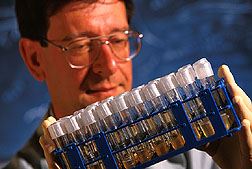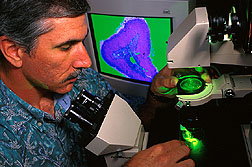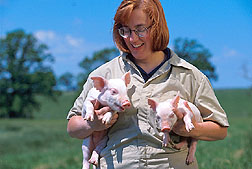Helping Piglets Survive and Thrive
|
|
Getting newborn piglets off to a good start in life is no easy task, even though raising hogs is among the most technologically advanced of animal industries. Of every 10 pigs born alive, at least 1 doesn't survive more than a few days. Those losses alone reduce swine producers' net income by several hundred million dollars a year.
Some piglets handle stress poorly, are prone to disease, weigh less than their siblings at weaning, and require an additional week or longer of care and feeding before going to market. Faster growth would lower housing, feeding, and other costs.
"Reducing the average time from birth to market by just 1 day could translate into an annual income boost of tens of millions of dollars for the nation's swine producers," says ARS animal physiologist Robert L. Matteri. He's based in the ARS Animal Physiology Research Unit, at Columbia, Missouri.
Matteri's team of three ARS scientists along with their University of Missouri colleagues are researching piglets' susceptibility to death, disease, stress, and poor growth. "Our goal is to find ways to improve their well-being and to optimize cost-efficient growth," says Matteri. Pigs that grow well when quite young generally gain more weight per pound of feed consumed after weaning and have less carcass fat when they reach market weight.
You Can Lead a Pig to Food . . .
A major limitation to improved neonatal growth is poor feed intake. That's why the scientists are looking at a variety of hormones involved in appetite control. The researchers must conduct extensive physiological research before they can develop practical farm procedures for using hormones like neuropeptide-Y, leptin, and orexins in the forms of orexin-A and orexin-B.
Matteri and ARS animal physiologist Cheryl J. Dyer became interested in orexin after University of Texas scientists saw a sixfold increase in feed intake in rats given brain injections of the hormone. The researchers in Missouri then found that a single injection in the upper hind leg muscles of 3-week-old pigs increased feed intake 18 percent, though for only a short time.
These initial findings earned the National Pork Producers Council's innovation award for basic research earlier this year at the Midwest Animal Sciences meeting in Des Moines, Iowa. More research should show whether two or more well-timed injections can help improve growth rates enough to be worthwhile.
|
|
Dyer and Matteri cloned the orexin molecule chemically. When analogs, which are smaller but potent synthetic versions, of orexin are designed and mass-produced, Dyer says, the cost of injections should become fairly inexpensive.
If treatments with hormones such as orexin could help all littermates grow at nearly the same pace, meat packers discounts of $0.50 to $2.50 per hundredweight on lightweight hogs could be avoided. And if all hogs could be marketed together, farmers could take better advantage of an "all-in, all-out" inventory management system that helps break disease cycles. This system—marketing all animals at the same time—allows producers to completely empty housing for thorough, periodic sanitation.
The scientists are researching another way to deliver orexin. They have cloned the genetic material, or DNA, that directs orexin production and have integrated it into another piece of DNA called a mammalian expression vector. The next step: injecting the new DNA, a so-called designer gene, into the animals' own cells to see if they will produce larger amounts of biologically active orexin.
The research on appetite regulation being conducted at Columbia complements ongoing work at other ARS laboratories. ARS researchers at Athens, Georgia, and Beltsville, Maryland, are studying the biology of leptin, a hormone that also controls appetite. The goal of these coordinated, and often collaborative, ARS research efforts is a working understanding of the biological control of feed intake as it relates to animal production, health, and well-being.
Birth and Other Stresses
Besides affecting appetite, hormones—in complex ways—exert major impact on swine health in production environments. There, for better or worse, stress is encountered—especially at birth—as pigs are weaned, handled, and moved about. In researching hormones that indicate stress, ARS animal physiologist Jeffery A. Carroll and his colleagues in Columbia have found that stress during birth may play an important role in preparing a fetus for life beyond the womb.
In the experiments, some young pigs were born naturally while others came into the world via cesarian section. At birth, blood and tissue samples from the two groups contained some similar but other strikingly different hormone and chemical levels. Two weeks later, more similarities and differences appeared, giving insights on lasting effects of birth experiences. The researchers concluded that by preventing the stress of natural birth, surgical birth inhibited the pigs' growth.
|
|
Diet may also have an important link with stress. Carroll has just begun researching the effects of new protein supplements like spray-dried plasma on the secretion of stress-related hormones after animals are confronted with real or simulated disease. This research is aimed at identifying and controlling responses to stress.
In a multifaceted study of newborn piglets' general ability to develop resistance to diseases, Carroll and Matteri have been exploring the effects of environmental temperature. The research has shown that the piglets, lacking the ability to develop an acute fever, actually become hypothermic—that is, lose body temperature—during a disease challenge. Chilling may, and often does, lead to death.
The scientists treated piglets with an anti-inflammatory drug similar to aspirin and ibuprofen before injecting them with a lipopolysaccharide from killed bacteria to simulate infection by a live disease organism. The drug prevented hypothermia. More important, by observing chilling and changes in body chemistry in pigs with and without the drug, the scientists are now on the way to finding ways to improve growth and reduce sickness and death among young pigs.—By Ben Hardin, Agricultural Research Service Information Staff.
This research is part of Animal Well-Being and Stress Control Systems, an ARS National Program described on the World Wide Web at http://www.nps.ars.usda.gov/programs/appvs.htm.
Robert L. Matteri, Jeffery A. Carroll, and Cheryl J. Dyer are in the USDA-ARS Animal Physiology Research Unit, 920 E. Campus Dr., University of Missouri, Columbia, MO 65211; phone (573) 882-1047, fax (573) 884-4798.
"Helping Piglets Survive and Thrive" was published in the September 1999 issue of Agricultural Research magazine.









